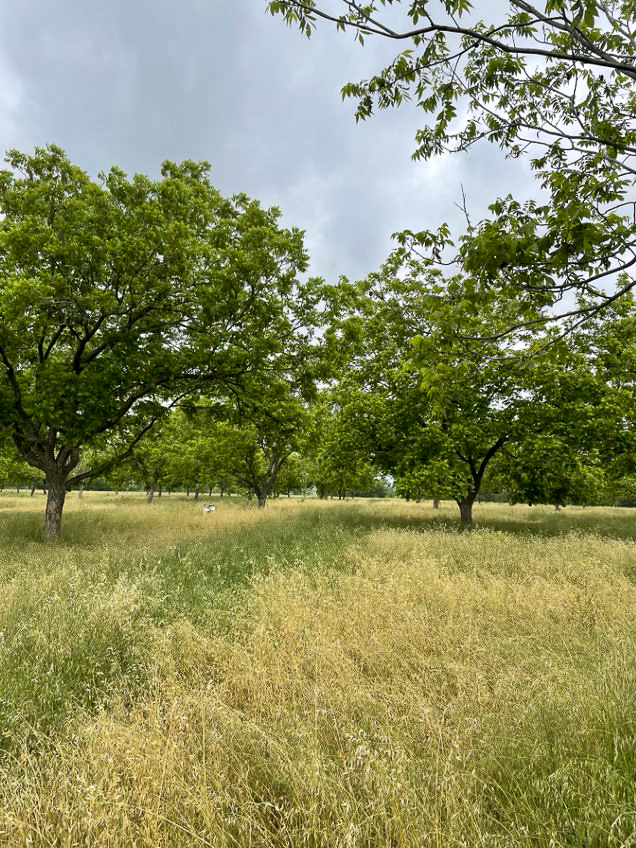Evaluate Your Expenses to Help Reduce Your Costs

Having a variety of species of forages growing in the orchard help feed the microbes in the soil resulting in healthier soils. (Photo by Lauren Jones, Noble Research Institute)
I have had the opportunity to visit with several growers who have been managing their orchards with a focus on soil health and regenerative principles. Most of these growers talk about the savings they have seen in fewer trips through the orchard, lower cost of irrigation, and reduced fertilizer and chemicals. So, I wanted to challenge you to start thinking about how you spend money and whether your current management practices are returning the best value for your money.
We have preached for years that the best money a manager can spend is taking your leaf samples each year to determine your trees’ nutritional needs. But do not just go off the recommendations from the leaf samples; there are other observations that you should consider before pulling the trigger to spend that money on a fertilizer. I have written about observing last year’s growth to determine if your past fertilizer program was significant. Larry Stein also wrote about this same topic the previous month. The other thing we have discussed in past articles is using the Haney soil test to evaluate what nutrients are available in the soil for the trees (Refer to Dr. Graham’s article from March 2024). As discussed in previous articles, we have not determined if the Haney test and leaf samples are correlated. Still, using the Haney test in other crops can reduce fertilizer needs.
How many of you believe in the golf course management strategy for your orchard floor management? A well-managed orchard must have a manicured appearance. My question to you is, what are the real benefits of this practice? Each time you mow, especially if you are mowing short, you are reducing the root system of those plants and causing them to use more nutrients and water from the soil, taking these away from our trees. You are also impacting your microbial populations that give you free nutrients. The shorter the grass is, the higher the soil temperature is, the higher the water evaporation is, and the slower the water infiltration is.
When you have taller ground cover and a rainfall or irrigation event occurs, the residue helps slow the water runoff and increases the soil infiltration. The soil water holding capacity will increase with more residue and higher organic matter. This increase will help both irrigated and non-irrigated orchards. We know that water management is critical to produce high-quality crops. Management of your groundcovers and improving your soil health can have a dramatic impact on your water management.
Several growers managing their soils following the soil health principles have shared that they do not have to irrigate as much as they once did and sufficiently less than their neighbors. Water moisture sensors allow them to see when an irrigation event is needed, and they only water when required instead of watering on a schedule. I have had growers managing soil health tell me that their irrigation amounts are about 20 to 50% less than others in their area without impacting quality or quantity. Irrigation is costly, and saving 20% on your water cost would significantly impact your expenses. Since you would be mowing less, you can add those savings on top of that. Now, think about the total you would save on input costs.
Another note that producers allowing their ground cover to grow in their orchards have shared with me is that they have less need for pesticides (especially aphid control). Allowing the ground covers to flower attracts beneficial insects that help control some of the pests in your orchards. The USDA has been researching other beneficial microorganisms that show promise in helping control pecan weevils, and having a healthy soil will aid in maintaining a population of these beneficial microorganisms.
Furthermore, increasing monitoring across your orchard and using the gathered data to make informed decisions can significantly reduce your input costs. So, as the new pecan season starts, before you start spending money on the typical management things you always do, I encourage you to think, “Why am I doing this? What is the actual benefit? And is there an alternative management practice that could save me money?”
To be successful, businesspeople must stop worrying about what others think and do what works best for them. Suppose you are trying to be as profitable as possible. In that case, your management may be dramatically different than that of other growers, and your orchards may look different (not a nicely manicured mowed orchard). We must start looking at things differently and doing the right thing for the business, not just doing things because we have always done them this way.

